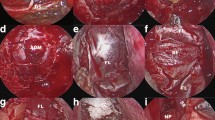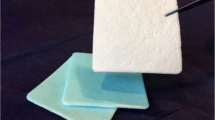Abstract
The efficacy of spinal drain (SD) placement for cerebrospinal fluid (CSF) leakage prevention after the anterior transpetrosal approach (ATPA) remains unclear. Thus, we aimed to assess whether postoperative SD placement improved postoperative CSF leakage after a skull base reconstruction procedure using a small abdominal fat and pericranial flap and clarify whether bed rest with postoperative SD placement increased the length of hospital stay. This retrospective cohort study included 48 patients who underwent primary surgery using ATPA between August 2011 and February 2022. All cases underwent SD placement preoperatively. First, we evaluated the necessity of SD placement for CSF leakage prevention by comparing the postoperative routine continuous SD placement period to a period in which the SD was removed immediately after surgery. Second, the effects of different SD placement durations were evaluated to understand the adverse effects of SD placement requiring bed rest. No patient with or without postoperative continuous SD placement developed CSF leakage. The median postoperative time to first ambulation was 3 days shorter (P < 0.05), and the length of hospital stay was 7 days shorter (P < 0.05) for patients who underwent SD removal immediately after surgery (2 and 12 days, respectively) than for those who underwent SD removal on postoperative day 1 (5 and 19 days, respectively). This skull base reconstruction technique was effective in preventing CSF leakage in patients undergoing ATPA, and postoperative SD placement was not necessary. Removing the SD immediately after surgery can lead to earlier postoperative ambulation and shorter hospital stay by reducing medical complications and improving functional capacity.




Similar content being viewed by others
Data availability
All data generated or analyzed during the study are included in this published article.
References
Adachi K, Hasegawa M, Hayakawa M, Tateyama S, Hirose Y (2019) Susceptibility-weighted imaging of deep venous congestion in petroclival meningioma. World Neurosurg 122:e20–e31. https://doi.org/10.1016/j.wneu.2018.08.218
Adachi K, Hasegawa M, Hirose Y (2017) Evaluation of venous drainage patterns for skull base meningioma surgery. Neurol Med Chir (Tokyo) 57:505–512. https://doi.org/10.2176/nmc.ra.2016-0336
Adachi K, Hasegawa M, Hirose Y (2021) Prediction of trigeminal nerve position based on the main feeding artery in petroclival meningioma. Neurosurg Rev 44:1173–1181. https://doi.org/10.1007/s10143-020-01313-3
Adachi K, Hasegawa M, Tateyama S, Kawazoe Y, Hirose Y (2018) Surgical strategy for and anatomic locations of petroapex and petroclival meningiomas based on evaluation of the feeding artery. World Neurosurg 116:e611–e623. https://doi.org/10.1016/j.wneu.2018.05.052
Adachi K, Hayakawa M, Ishihara K, Ganaha T, Nagahisa S, Hasegawa M, Hirose Y (2016) Study of changing intracranial venous drainage patterns in petroclival meningioma. World Neurosurg 92:339–348. https://doi.org/10.1016/j.wneu.2016.05.019
Adachi K, Kawase T, Yoshida K, Yazaki T, Onozuka S (2009) ABC Surgical Risk Scale for skull base meningioma: a new scoring system for predicting the extent of tumor removal and neurological outcome. Clinical article. J Neurosurg 111:1053–1061. https://doi.org/10.3171/2007.11.17446
Adachi K, Murayama K, Hayakawa M, Hasegawa M, Muto J, Nishiyama Y, Ohba S, Hirose Y (2021) Objective and quantitative evaluation of angiographic vascularity in meningioma: parameters of dynamic susceptibility contrast-perfusion-weighted imaging as clinical indicators of preoperative embolization. Neurosurg Rev 44:2629–2638. https://doi.org/10.1007/s10143-020-01431-y
Allen KP, Isaacson B, Purcell P, Kutz JW Jr, Roland PS (2011) Lumbar subarachnoid drainage in cerebrospinal fluid leaks after lateral skull base surgery. Otol Neurotol 32:1522–1524. https://doi.org/10.1097/MAO.0b013e318232e387
Bien AG, Bowdino B, Moore G, Leibrock L (2007) Utilization of preoperative cerebrospinal fluid drain in skull base surgery. Skull Base 17:133–139. https://doi.org/10.1055/s-2007-970562
Borghei-Razavi H, Truong HQ, Fernandes Cabral DT, Sun X, Celtikci E, Wang E, Snyderman C, Gardner PA, Fernandez-Miranda JC (2019) Endoscopic endonasal petrosectomy: anatomical investigation, limitations, and surgical relevance. Oper Neurosurg (Hagerstown) 16:557–570. https://doi.org/10.1093/ons/opy195
Coucke B, Van Gerven L, De Vleeschouwer S, Van Calenbergh F, van Loon J, Theys T (2021) The incidence of postoperative cerebrospinal fluid leakage after elective cranial surgery: a systematic review. Neurosurg Rev. https://doi.org/10.1007/s10143-021-01641-y
Dalle Ore CL, Magill ST, Rodriguez Rubio R, Shahin MN, Aghi MK, Theodosopoulos PV, Villanueva-Meyer JE, Kersten RC, Idowu OO, Vagefi MR, McDermott MW (2020) Hyperostosing sphenoid wing meningiomas: surgical outcomes and strategy for bone resection and multidisciplinary orbital reconstruction. J Neurosurg 134:711–720. https://doi.org/10.3171/2019.12.JNS192543
Dirks ML, Stephens FB, Jackman SR, Galera Gordo J, Machin DJ, Pulsford RM, van Loon LJC, Wall BT (2018) A single day of bed rest, irrespective of energy balance, does not affect skeletal muscle gene expression or insulin sensitivity. Exp Physiol 103:860–875. https://doi.org/10.1113/EP086961
Dirks ML, Wall BT, van de Valk B, Holloway TM, Holloway GP, Chabowski A, Goossens GH, van Loon LJ (2016) One week of bed rest leads to substantial muscle atrophy and induces whole-body insulin resistance in the absence of skeletal muscle lipid accumulation. Diabetes 65:2862–2875. https://doi.org/10.2337/db15-1661
Falcioni M, Sanna M (2001) Cerebrospinal fluid leak after acoustic surgery. J Neurosurg 95:373–374. https://doi.org/10.3171/jns.2001.95.2.0373
Farshad M, Aichmair A, Wanivenhaus F, Betz M, Spirig J, Bauer DE (2020) No benefit of early versus late ambulation after incidental durotomy in lumbar spine surgery: a randomized controlled trial. Eur Spine J 29:141–146. https://doi.org/10.1007/s00586-019-06144-5
Forbes JA, Ordonez-Rubiano EG, Tomasiewicz HC, Banu MA, Younus I, Dobri GA, Phillips CD, Kacker A, Cisse B, Anand VK, Schwartz TH (2018) Endonasal endoscopic transsphenoidal resection of intrinsic third ventricular craniopharyngioma: surgical results. J Neurosurg 131:1152–1162. https://doi.org/10.3171/2018.5.JNS18198
Freeman JL, Sampath R, Quattlebaum SC, Casey MA, Folzenlogen ZA, Ramakrishnan VR, Youssef AS (2018) Expanding the endoscopic transpterygoid corridor to the petroclival region: anatomical study and volumetric comparative analysis. J Neurosurg 128:1855–1864. https://doi.org/10.3171/2017.1.JNS161788
Hasanbelliu A, Andaluz N, Di Somma A, Keller JT, Zimmer LA, Samy RN, Pensak ML, Zuccarello M (2020) Extended anterior petrosectomy through the transcranial middle fossa approach and extended endoscopic transsphenoidal-transclival approach: qualitative and quantitative anatomic analysis. World Neurosurg 138:e405–e412. https://doi.org/10.1016/j.wneu.2020.02.127
Kreatsoulas DC, Shah VS, Otto BA, Carrau RL, Prevedello DM, Hardesty DA (2020) Surgical outcomes of the endonasal endoscopic approach within a standardized management protocol for repair of spontaneous cerebrospinal fluid rhinorrhea. J Neurosurg 134:780–786. https://doi.org/10.3171/2019.12.JNS192891
Muto J, Prevedello DM, Ditzel Filho LF, Tang IP, Oyama K, Kerr EE, Otto BA, Kawase T, Yoshida K, Carrau RL (2016) Comparative analysis of the anterior transpetrosal approach with the endoscopic endonasal approach to the petroclival region. J Neurosurg 125:1171–1186. https://doi.org/10.3171/2015.8.JNS15302
Panigrahi M, Venkateswaraprasanna G (2006) Transpetrosal approach. J Neurosurg 105:336–337. https://doi.org/10.3171/jns.2006.105.2.336. (author reply 337-338)
Piek J, Weber C, Kundt G, Tronnier V, Spuck S, Hirdes C, Kehler U, Ditges C (2012) Pharmacoeconomical consequences of postoperative CSF leaks after intracranial surgery–a prospective analysis. J Neurol Surg A Cent Eur Neurosurg 73:25–28. https://doi.org/10.1055/s-0032-1304501
Radcliff KE, Sidhu GD, Kepler CK, Gruskay J, Anderson DG, Hilibrand A, Albert TJ, Vaccaro AR (2016) Complications of flat bed rest after incidental durotomy. Clin Spine Surg 29:281–284. https://doi.org/10.1097/BSD.0b013e31827d7ad8
Rao RM, Shrivastava A, Nair S (2020) Anterior transpetrosal approach for petroclival meningioma: operative nuances. Neurol India 68:20–25. https://doi.org/10.4103/0028-3886.279689
Robson CH, Paranathala MP, Dobson G, Ly F, Brown DP, O'Reilly G (2018) Early mobilisation does not increase the complication rate from unintended lumbar durotomy. Br J Neurosurg 37:460–465. https://doi.org/10.1080/02688697.2018.1508641
Scheithauer S, Burgel U, Bickenbach J, Hafner H, Haase G, Waitschies B, Reinges MH, Lemmen SW (2010) External ventricular and lumbar drainage-associated meningoventriculitis: prospective analysis of time-dependent infection rates and risk factor analysis. Infection 38:205–209. https://doi.org/10.1007/s15010-010-0006-3
Seifert V, Raabe A, Zimmermann M (2003) Conservative (labyrinth-preserving) transpetrosal approach to the clivus and petroclival region–indications, complications, results and lessons learned. Acta Neurochir (Wien) 145:631–642. https://doi.org/10.1007/s00701-003-0086-2. (discussion 642)
Suesada MM, Martins MA, Carvalho CR (2007) Effect of short-term hospitalization on functional capacity in patients not restricted to bed. Am J Phys Med Rehabil 86:455–462. https://doi.org/10.1097/PHM.0b013e31805b7566
Suetta C (2017) Plasticity and function of human skeletal muscle in relation to disuse and rehabilitation: Influence of ageing and surgery. Dan Med J 64:1–28
Tamura R, Tomio R, Mohammad F, Toda M, Yoshida K (2018) Analysis of various tracts of mastoid air cells related to CSF leak after the anterior transpetrosal approach. J Neurosurg 130:360–367. https://doi.org/10.3171/2017.9.JNS171622
Tan J, Song R, Huan R, Huang N, Chen J (2020) Intraoperative lumbar drainage can prevent cerebrospinal fluid leakage during transsphenoidal surgery for pituitary adenomas: a systematic review and meta-analysis. BMC Neurol 20:303. https://doi.org/10.1186/s12883-020-01877-z
Topczewski TE, Di Somma A, Pineda J, Ferres A, Torales J, Reyes L, Morillas R, Solari D, Cavallo LM, Cappabianca P, Ensenat J, Prats-Galino A (2020) Endoscopic endonasal and transorbital routes to the petrous apex: anatomic comparative study of two pathways. Acta Neurochir (Wien) 162:2097–2109. https://doi.org/10.1007/s00701-020-04451-1
van Lieshout C, Slot EMH, Kinaci A, Kollen MH, Hoving EW, Frederix GWJ, van Doormaal TPC (2021) Cerebrospinal fluid leakage costs after craniotomy and health economic assessment of incidence reduction from a hospital perspective in the Netherlands. BMJ Open 11:e052553. https://doi.org/10.1136/bmjopen-2021-052553
Verma K, Freelin AH, Atkinson KA, Graham RS, Broaddus WC (2022) Early mobilization versus bed rest for incidental durotomy: an institutional cohort study. J Neurosurg Spine 37:460–465. https://doi.org/10.3171/2022.1.SPINE211208
Wall BT, Dirks ML, van Loon LJ (2013) Skeletal muscle atrophy during short-term disuse: implications for age-related sarcopenia. Ageing Res Rev 12:898–906. https://doi.org/10.1016/j.arr.2013.07.003
Yoshida K, Kawase T (1999) Trigeminal neurinomas extending into multiple fossae: surgical methods and review of the literature. J Neurosurg 91:202–211. https://doi.org/10.3171/jns.1999.91.2.0202
Zwagerman NT, Wang EW, Shin SS, Chang YF, Fernandez-Miranda JC, Snyderman CH, Gardner PA (2018) Does lumbar drainage reduce postoperative cerebrospinal fluid leak after endoscopic endonasal skull base surgery? A prospective, randomized controlled trial. J Neurosurg 131:1172–1178. https://doi.org/10.3171/2018.4.JNS172447
Author information
Authors and Affiliations
Contributions
All authors contributed to the study concept and design. Material preparation, data collection, and analysis were performed by Kazuhide Adachi, Mituhiro Hasegawa, and Yuichi Hirose. The first draft of the manuscript was written by Kazuhide Adachi, and all authors commented on the early versions of the manuscript. All authors read and approved the final manuscript.
Corresponding author
Ethics declarations
Ethics approval
This retrospective cohort study was approved by the institutional review board of Fujita Health University Hospital (approval number HM21-525).
Consent to participate
An opt-out method was used for all potential study participants. Written informed consent is not required in opt-out approach as all participants are included in the study unless they express their desire to be excluded.
Consent for publication
The participants have all consented to submitting their case report for journal publication.
Competing interests
The authors declare no competing interests.
Additional information
Publisher's note
Springer Nature remains neutral with regard to jurisdictional claims in published maps and institutional affiliations.
Supplementary Information
Below is the link to the electronic supplementary material.
Supplementary file1 (MP4 242621 KB)
Rights and permissions
Springer Nature or its licensor (e.g. a society or other partner) holds exclusive rights to this article under a publishing agreement with the author(s) or other rightsholder(s); author self-archiving of the accepted manuscript version of this article is solely governed by the terms of such publishing agreement and applicable law.
About this article
Cite this article
Adachi, K., Hasegawa, M. & Hirose, Y. Cerebrospinal fluid leakage prevention using the anterior transpetrosal approach with versus without postoperative spinal drainage: an institutional cohort study. Neurosurg Rev 46, 137 (2023). https://doi.org/10.1007/s10143-023-02045-w
Received:
Revised:
Accepted:
Published:
DOI: https://doi.org/10.1007/s10143-023-02045-w




